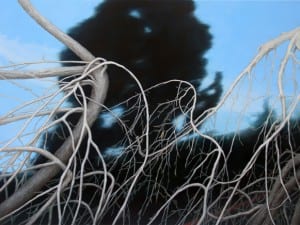The Asia Pacific Triennial of Contemporary Art (APT) at the recently revamped GOMA in Brisbane, Australia, is a pastiche of works from the many regions of Asia, the Pacific, and Australian Aboriginal communities. Because of the vastness and variation of the regions and styles covered by the triennial, APT curators focus for each event on a loose theme, this year’s being ephemeral structures based on the Spirit Houses of the Papua New Guinean people of the Sepik river region.
On entering the three-story light-filled GOMA, the first of the Spirit Houses, built by the Abelam group and spanning the multi-story atrium entrance, rises majestically before the viewer. A second Spirit House around the corner constructed by the Kwoma, a different language group with subtle cult differences, has a similar effect of rousing awe, not just by its sheer size and we assume, domestic sacredness, but for art viewers, by way of what André Breton defined in magical transference: the ability of a startling or enigmatic object to emit surreal energy.
The first piece is thatched and triangular, the second is without sides and set horizontally among an installation of Baining masks; both depict in striking polychrome paintings, mask sculpture and sacred architectural practice, the secrets of their spiritual cults. These groups of artists were discovered in their native villages by APT Pacific curators Maud Page and Ruth McDougall assisted by architect Martin Fowler, and commissioned by APT7 to come to GOMA to create these works for the spaces – works of Papuan ceremonial art that have never been featured on this scale before.
On the third floor, there are works by the Asmat people of the Irian Jaya side of Papua New Guinea – Bisj Poles, richly ornamented ancestor poles, and Wuramon, colourful carved canoes filled with spirit ancestors who pave the way for the dead. These are adjacent to Australian Aboriginal artist Lorraine Conelly-Northey’s playfully oversized Narrbong, tribal bags and vessels constructed of rusted iron and wire, a contrastingly contemporary take on a traditional people’s sacred objects.
This motif of clashing artisanal with conceptual continues throughout the exhibit. Further along the third floor, Maori photographic artist Greg Semu’s large format portraits of colonial themes: Mary mourning Jesus dismounted from the cross, Napoleon atop his stallion à la Jacques Louis David, acted out by indigenous people in their tribal tattooing and traditional garb is particularly memorable. On the first floor, Baining masks adorned in polymer-painted polystyrene Virgin Mary’s appear, and are set beside Big Yellow, an enormous bright yellow amorphous sculpture by Richard Maloy in recycled cardboard and tape. The room opening onto these works displays a series of paintings by Graham Fletcher, a New Zealand painter of mixed Samoan and European heritage, whose series Lounge Room Tribalism depicts modern era living rooms punctuated by tribal art that haunts the controlled domestic spaces, and seems to mourn the loss of a more deeply meaningful indigenous knowledge. These paintings themselves haunt the exhibition and have it ask of itself whether and how its staging might employ the sacred talismans of real practitioners to fill a hole in Western culture; leaving us to ponder the meaning of art, the definition of contemporary, and whether artistic practice is simply the result of an accumulation of knowledge in material expression.
Room upon room weave sub-themes into this larger one via the many forks in the road of contemporary Asian art. Features include Yuan Goang-Ming’s moving meditation on death in the film Disappearing Landscape – Passing II. Huang Yong Ping’s colossal Ressort, a metallic serpent skeleton snaking up the atrium of the original GOMA building, reminisces on both trips to the museum as a child and the magical realism of the I Ching. O – Now: Traversing Western Asia, a space devoted to the photography, video, sculpture and multimedia installations of seven West Asian artists, poignantly explores historicity and the shifting of power in their experience of their unstable region.
The kaleidoscopic ambition of this event, now in it’s twentieth year, is extolled by curator of Asian art Reuben Keehan who reflects that, “Through it’s great diversity, from the fetishism of the primitive, to the Pacific retorts to colonialism, through the Asian reflection of diversity, the show is actually about Australia; when we look up from our geographical position to the North, these cultures, this art, is the lens through which we see the world”.
The 7th Asia Pacific Triennial of Contemporary Art (APT7), until 14 April, GOMA, Stanley Place, South Bank, Queensland 4101, Australia.
Caia Hagel
Credits
1. Richard Maloy, New Zealand b.1977, Big Yellow 2012 Cardboard, paint, wood, Site-specific work for APT7 Courtesy: The artist and Sue Crockford Gallery, Auckland The Queensland Art Gallery would like to thank IKEA for the generous donation of cardboard for Richard Maloy’s project Big Yellow.
2. Huang Yong Ping, China/France b.1954 | Ressort 2012 | Aluminium, stainless steel | Purchased 2012 with funds from Tim Fairfax, AM, through the Queensland Art Gallery Foundation | Collection: Queensland Art Gallery | © The artist.
3. THE PROPELLER GROUP Est. 2006 Vietnam/United States Birds of No Nation (from Viet Nam The World Tour 2010–ongoing) 2012 A collaborative project created with Shamsia Hassani (Kabul, Afghanistan) and El Mac (Los Angeles, United States)Image courtesy: Queensland Art Gallery │ Gallery of Modern Art.
4. Installation view of ‘The 7th Asia Pacific Triennial of Contemporary Art’ (APT7), Gallery of Modern Art (GoMA), Brisbane. Including O nunu 2011 and O ptaek 2011 by Sulka People (Collaborative Group, Sulka people, Bitapaka, PNG: Camilus Tepe, Paskalis Bill, Moky Camilius, Makude Joeseph, Tadius Lohali, Joeseph Lormot, Herman Pape, Antonius Savuo Jr, Herman Tep, Bernard Vieton) and Koromb (Spirit house) 2012 by Kwoma Arts (Collaborative Group, Kwoma people, Tongwinjamb, PNG est. 2012: Anton Waiawas, Kevin Apsepa, Simon Goiyap, Jamie Jimok, Nelson Makamoi, Rex Maukos, Terry Pakiey.



